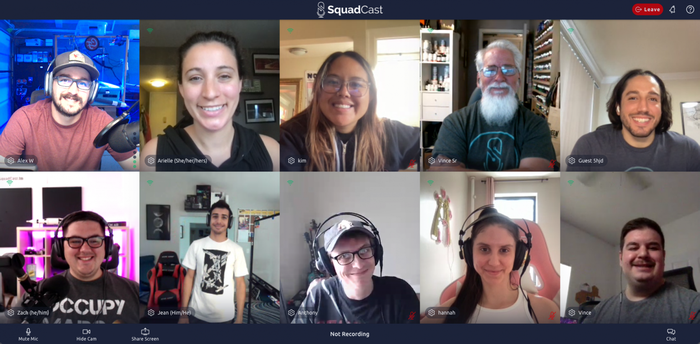 Remote podcast interview recording platform SquadCast has released v4 of its built-in toolkit, adding features which dramatically enlarge group sizes, and appear to rival and automate certain mastering capabilities of DAWs (digital audio workstations).
Remote podcast interview recording platform SquadCast has released v4 of its built-in toolkit, adding features which dramatically enlarge group sizes, and appear to rival and automate certain mastering capabilities of DAWs (digital audio workstations).
The headline update is an expansion of group calls to 10 people — one host a nine guests. That limit should accommodate nearly all podcast interview and panel discussion scenarios. SquadCast records separate audio files for each participant in a call. Squadcast also works with video.

SquadCast has also added Dolby audio management features. Notable among them is noise cancelling which can reportedly identify extraneous noise and silence (or near-silence) it in real time. A video demonstrates how this works — though it’s impossible to know whether the audio in that video was separately mastered to remove noise. To whatever extent the noise reduction is effective, it seems to mimic a DAW’s gate function, which traditionally is sometimes used in audio mastering to clip out unwanted background noise.
That feature is part of an overall product update called One-Click Audio Mastering with Dolby, and includes these finishing effects:
- Normalize loudness to -16 LUFS, the industry standard, with Dolby Dialog Intelligence
- Optimize speech dynamics and tonality that may be skewed by microphone technique
- Reduce background noise and sounds that are not human speech
- Filter out undesirable noises like thumps and low-frequency hums under 100 Hz
- Reduce sibilance from harsh consonant sounds like “s”, “ch”, or “th” to enhance speech
Worth noting that while the #1 feature above is standard and easily automated, the others traditionally require fine-tuned engineering of software plug-ins or outboard hardware. If One-Click Audio Mastering works as advertised in all or most situations, it is a masterful piece of automation.
Screen sharing is a new video feature in SquadCast’s v4 update. This puts the video tool on a par with Zoom in that regard, and we presume that the wide use of screen sharing in the Zoom Era led to this development.
Two other features we think are cool: Green room sound checks, and network connectivity meters showing signal strengths of participants.
.
